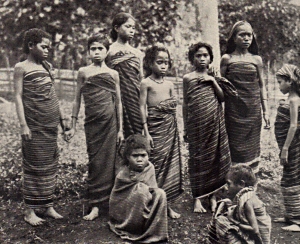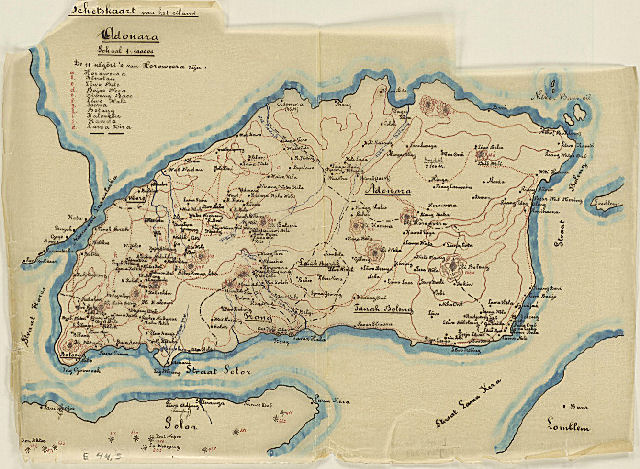Under-researched, ill-reputed AdonaraAdonara lies in the most western part of the Solor Archipelago just off the eastern tip of Flores, close to Larantuka. The landscape is dominated by the volcano Ili Boleng in the east of the island, which rises to 1650m. Not much is known about Adonara and its indigenous culture, or what remains of it after the onslaught of christianisation and islamisation. The one thing that appears certain is that its people, divided into half a dozen tribes that speak as many languages, most of them mutually unintelligible, are highly bellicose by nature. Inter-village warfare was very common in previous centuries, and occurred as late as the second half of the 20th C. As Ernst Vatter wrote in his 1932, Ata Kiwan, based on extensive travel in the region, "There is no other area in the eastern Dutch Indies in which so many murders take place as on Adonara, [..] no other island has such a bad reputation, both among the Europeans and the natives of neighboring areas." Vatter attributed this to the islanders "vanity bordering on the grotesque" coupled with "marked feelings of inferiority vis-à-vis their own race and culture, love of war and bloodthirst paired with mistrust and fear, and, finally, an unmistakable yearning for crude and horrible deeds..." Et cetera, one gets the drift. An important cultural distinction with the other parts of the Lamaholot regions, is that patola here are not common property of a clan, but privately owned by the rulers, which has allowed us to buy the magnificent elephant patolu from the Raja of Tarong. Homemade or imported, that is the question
It never occurred to us to try to buy any of these sarongs because they were so plain and unappealing - or, in the case of a few that seemed to have been made with vegetable dyes only, so worn and faded that we felt it not worth taking them. Unfortunately this is not the only mistake we made while travelling in the area. Older ikat cloths with certain Adonara provenance are very rare, in whatever condition. The question remains if the ikat work on these sarongs was actually done on Adonara. Some sources maintain that while weaving is practiced on Adonara, ikating is not. Vatter already spoke of bundles of yarn ready to weave being imported: "The women still spin and weave nearly exclusively for their own use [which in fact is the rule in much of the region, tH], and their products are not very attractive, as the homespun yarn, dyed red or blue, is never used by itself, but always interwoven with some bundles of shrill coloured import yarn from the Chinese toko. Ikating appears to be completely unknown. We did actually see some old sarongs with ikated bands, but, as we could ascertain, these had not been tied and dyed in the village itself, but bought as ready to use thread in East Flores or on Lomblem [Lembata], especially in the Gunung Api [Ili Api] region." Ruth Barnes, in her Ostindonesien im 20. Jahrhundert, contests Vatter's views and explains that ikat work is indeed done on the island, to wit in the Muslim community of Tanah Boleng, which also exports skeins with ikat to other parts of the island. This is about as much as is known about ikat on Adonara today. Few collectors of ethnographic material travel to mission-ravaged Adonara, and no researcher that we are aware of has embraced the island, perhaps as a result of its repute, so the dearth of information is likely to persist. A serious dearth of knowledgeThe lack of knowledge shows up even where we would not expect it. A few museums and dealers show ikat sarongs that are attributed to Adonara. In several cases those attributions are incorrect or questionable. Object 2002.1001 in the Art Institute of Chicago, for instance, is labeled 'Indonesia, Flores, possibly Adonara', while it is certainly not from Flores, possibly indeed from Adonara, but much more likely from Alor. This is not mentioned to censure the curator of the AIC (who actually added the note 'Due to ongoing research, information about this object is subject to change'), just to show how limited our collective knowledge of these cloths still is. In fact most of what we know of Adonara today we still owe to Ernst Vatter. | ||||||



